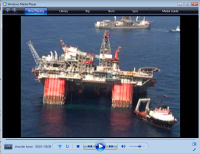BP Thunder Horse
Engineering marvel on the brink of disaster, July 2005
Authored: Martin Leduc, Aug 2006
Pictures by: USCG and other sources
Brought to you by www.dieselduck.net, comments to [email protected]
BP Thunder Horse, with a displacement of about 130,000 tons, is the largest and, reportedly, the most technologically advance Semi-Submersible deep-water platform ever built. Daewoo Shipbuilding built the hull at its Okpo yard in South Korea and J. Ray McDermott, an offshore oil construction company, completed the topside in the US, in Morgan City, Louisiana.
In March 2004, BP Thunder Horse was towed out of the Mississippi river and positioned about 150 miles southeast of New Orleans, in the Gulf of Mexico, destined to operate at a depth of 6,050feet (1,840meters). It is owned and self insured, primarily by BP
(British Petroleum) at 75%, with Exxon Mobil owning the other 25% share.
self insured, primarily by BP
(British Petroleum) at 75%, with Exxon Mobil owning the other 25% share.
BP Thunder Horse was scheduled to achieve production in late 2005, and when it does it will represent about 1% of total US oil production when its 250,000 barrel capacity comes online. �In mid July 2005, Hurricane Dennis swirled in the Gulf of Mexico and the platform was evacuated as a precaution. Upon return to the platform on July 12 2005, it was found precariously listing 20 to 30 degrees; the lower deck of the platform was at sea level.
The majority of the pictures seen here are from the US Coast Guard and illustrate this amazing near disaster. BP issued a press release on July 19th stating that SMIT had successfully completed salvage operations and that Thunder Horse was upright and had been made storm worthy. The loss of the platform reportedly would have cost BP and Exxon around 2 billion dollars.�
Click on the picture below to view a video of a flyover by the USCG of the platform.
I originally heard that the cause appeared to be human error in the operation of the ballast system before evacuation � �someone left a ballast valve open, flooding a ballast tank causing the list.� But it would appear, from various blogs, that it could be a mechanical failure.
They reports��
�one of the two manifolds that supply this massive platform has two major cracks in it. They have cut out a section of pipe and sent it to the University of Cambridge for a study to see if the problem is mechanic or systematic.��
Another blog comments that� �
�� the totally unconfirmed rumblings I'm hearing from multiple directions (reverberations?) indicate that isolation valves which would have normally been open during operation but closed when being readied for storms, were leaky. These leaks caused water to seep through the now idled pumps into the ballast tank causing the platform to take on water. SMIT has placed flange covers over the inlets as a stop-gap to allow their bailing pumps to keep up with the flooding.��
These pictures are pretty dramatic because of the great loss averted, but the whole rig and the sheer size and complexity of this project really is amazing even if it�s not in a disaster. You can find out more about the construction of the rig and the development of the field on the links below. �
www.offshore-technology.com
www.rigzone.com
www.bp.com
redinktexas.blogspot.com
www.rds.co.uk
www.resourceinvestor.com
www.bpthunderhorse.com
Update - April 2009
Offshore Engineer magazine reports that Thunder Horse is up and running... fast! The rig reached first oil in June 2008 and in April reached a production level of 310,000 boe/d (barrels per day) from just seven subsea wells, making the field the world's largest producer. Moored in 1900 meters of water the oil gushes out at 1200 bar 135 degrees Celsius.
















